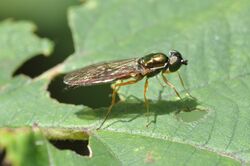Biology:Sargus bipunctatus
| Sargus bipunctatus | |
|---|---|

| |
| Scientific classification | |
| Domain: | Eukaryota |
| Kingdom: | Animalia |
| Phylum: | Arthropoda |
| Class: | Insecta |
| Order: | Diptera |
| Family: | Stratiomyidae |
| Subfamily: | Sarginae |
| Genus: | Sargus |
| Species: | S. bipunctatus
|
| Binomial name | |
| Sargus bipunctatus | |
| Synonyms | |
Sargus bipunctatus, the twin-spot centurion, is a European species of soldier fly. [3][4][5]
Description
Body length 10 to 14 mm. Frons less broad than in Sargus cuprarius. The mesonotum is metallic green; the abdomen brown, with a violet metallic tinge. Females have a broader build than the slender males with the base of the abdomen extensively reddish and a blackish tip bearing blue reflections. Wings slightly yellow. Red legs, tarsi brown at the apex. [6][7][8] [9]
Biology
Found in open and wooded habitats, sunbathing on foliage in sheltered spots. The flight period is from July to November. Females lay eggs on fresh dung, manure or in close by soil where the larvae develop. The larvae have been reared from cow dung, compost, rotting vegetation and decaying fungi. Larvae have been found in egg pods of locusts (Dociostaurus maroccanus Shnb.).
Distribution
Sargus bipunctatus can be found in the Trans-Caucasus Central belt and south of Western Europe.
References
- ↑ 1.0 1.1 Scopoli, I.A. (1763). Entomologia carniolica exhibens insecta carnioliae indigena et distributa in ordines, genera, species, varietates. Methodo Linnæana. Vindobonae [= Vienna]: Trattner. pp. [30] + 420 pp. https://www.biodiversitylibrary.org/item/209872#page/5/mode/1up. Retrieved 23 June 2021.
- ↑ Meigen, J.W. (1804). Klassifikazion und Beschreibung der europäische n zweiflugeligen Insekten (Diptera Linn.). Erster Band. Abt. I.. Braunschweig [= Brunswick]: Reichard. pp. xxviii + pp. 1–152, Abt. II. vi + pp. 153–314.
- ↑ Stubbs, Alan E; Drake, Martin (2014). British Soldierflies and their allies (an illustrated guide to their identification and ecology) (2 ed.). Reading: British Entomological and Natural History Society. pp. 528 pp, 20 plates. ISBN 9781899935079.
- ↑ Woodley, N.E. (2001). "A World Catalog of the Stratiomyidae (Diptera)". Myia 11: 1-462. https://www.researchgate.net/profile/Norman-Woodley/publication/303225468_A_World_Catalog_of_the_Stratiomyidae_Insecta_Diptera/links/5eac5d63299bf18b958e19bf/A-World-Catalog-of-the-Stratiomyidae-Insecta-Diptera.pdf. Retrieved 7 December 2022.
- ↑ Zeegers, T.; Schulten, A. (2022). Families of Flies with Three Pulvilli: Field Guide Northwest Europe. Graveland: Jeugdbondsuitgeverij. pp. 256pp. ISBN 9789051070682.
- ↑ Seguy. E. Faune de France Faune n° 13 1926. Diptères Brachycères.308 p., 685 fig.
- ↑ George Henry VerrallStratiomyidae and succeeding families of the Diptera Brachycera of Great Britain- British flies (1909) BHL Full text with illustrations
- ↑ E. P. Narchuk in Bei-Bienko, G. Ya, 1988 Keys to the insects of the European Part of the USSR Volume 5 (Diptera) Part 2 English edition. Keys to Palaearctic species but now needs revision.
- ↑ William Lundbeck Diptera Danica. Genera and species of flies Hitherto found in Denmark. Copenhagen & London,
1902-1927. 7 vols
 This article incorporates text from this source, which is in the public domain.
This article incorporates text from this source, which is in the public domain.
External links
Wikidata ☰ Q7423983 entry
 |

